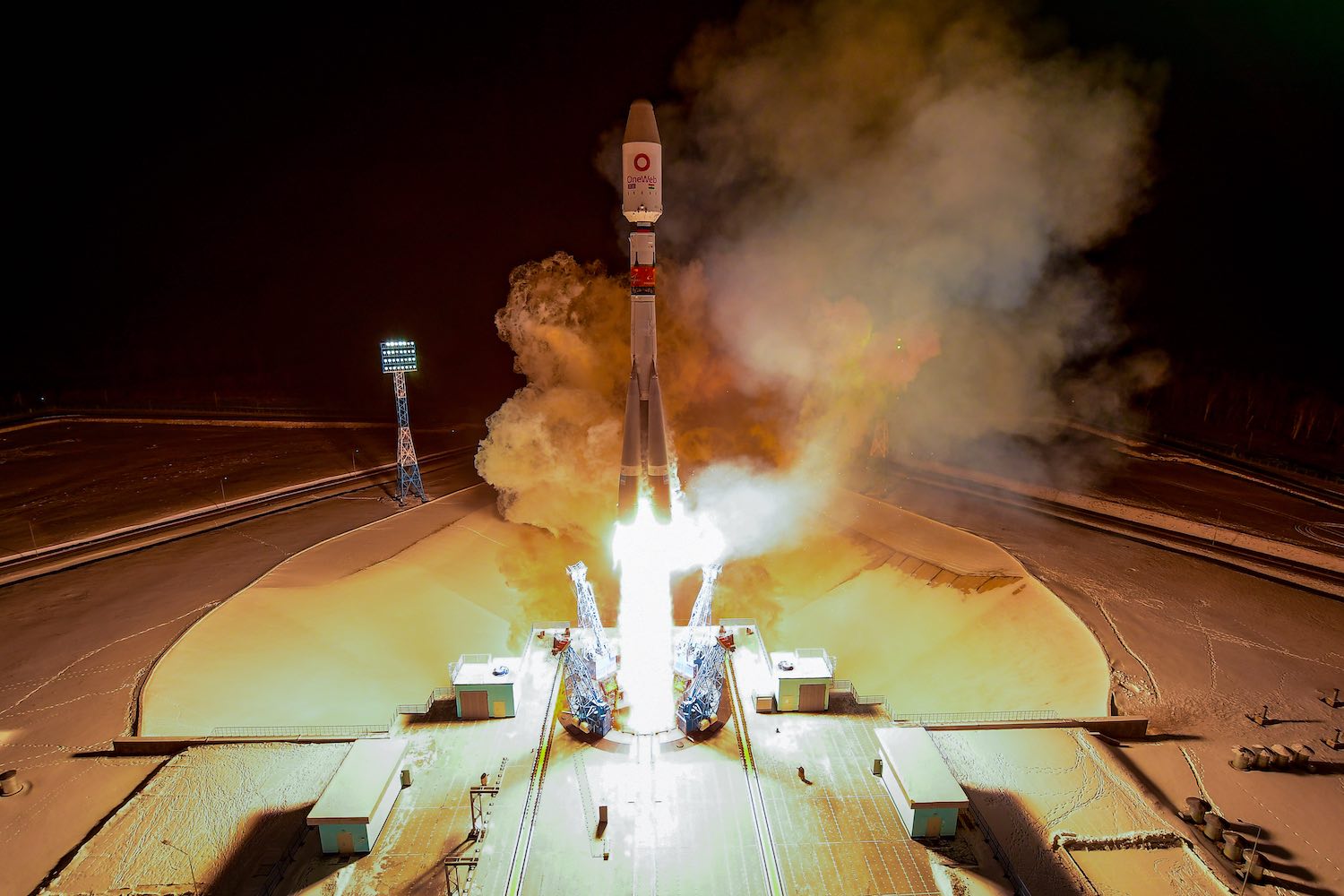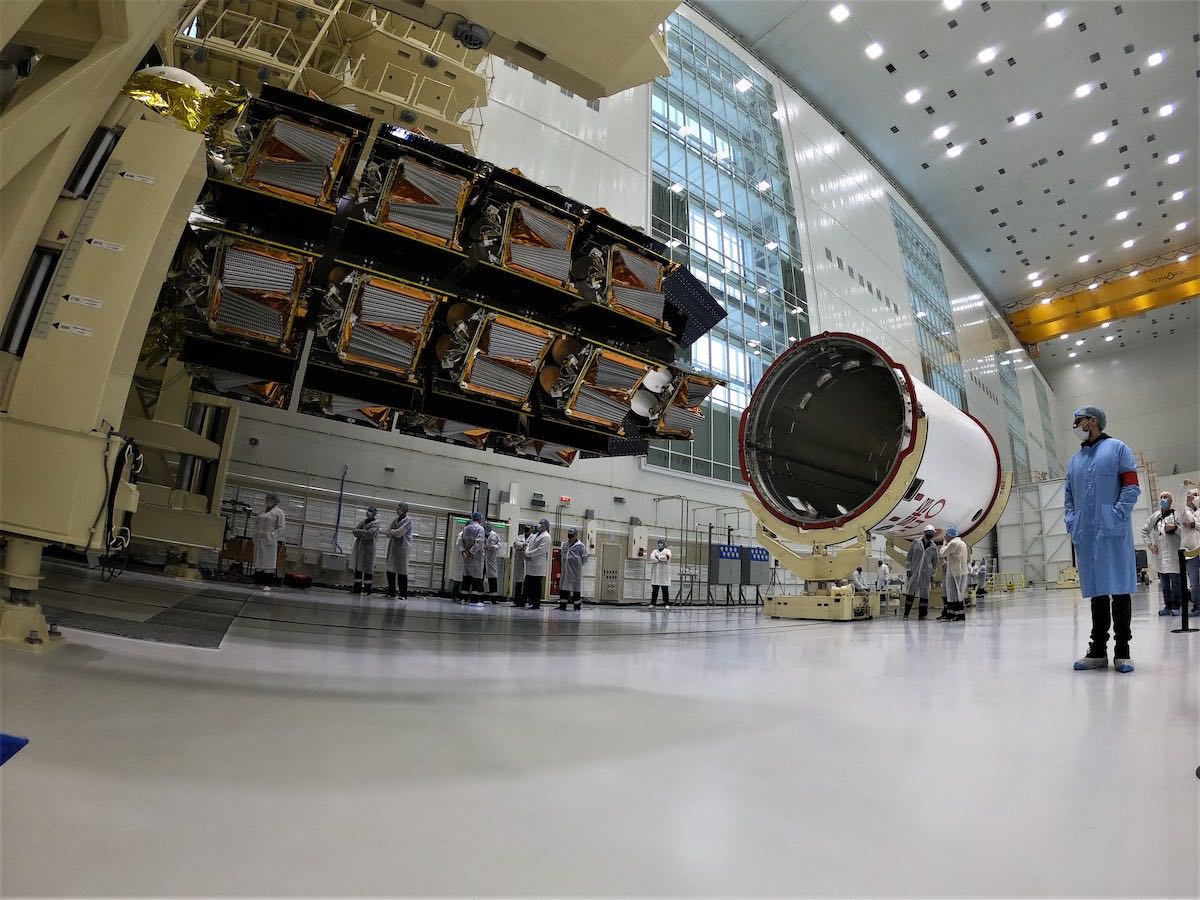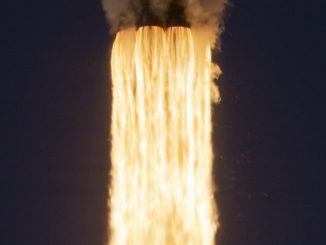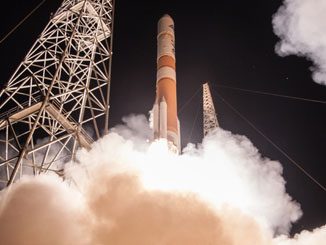
The next 36 satellites for OneWeb’s broadband internet network fired into orbit from Russia’s Far East Friday on a Soyuz rocket, giving OneWeb 110 of a planned fleet of 650 spacecraft after the company emerged from bankruptcy earlier this year.
Kerosene-fueled engines propelled the Soyuz-2.1b launcher and its Fregat upper stage off a launch pad at the Vostochny Cosmodrome in Russia at 7:26:26 a.m. EST (1226:26 GMT).
The three-stage Soyuz rocket completed its job in the first 10 minutes of the flight and released the Russian-made Fregat space tug to perform a series of propulsive maneuvers to place the 36 OneWeb satellites — each about the size of a mini-fridge — into a target orbit at an altitude of 280 miles (450 kilometers).
The Fregat stage carried a dispenser built by RUAG Space of Sweden to deploy the 36 satellites four at a time over the course of several hours. Roscosmos, the Russian space agency, and Arianespace, the French launch company overseeing the commercial mission, confirmed all 36 satellites separated from the Fregat upper stage as designed.
London-based OneWeb said ground teams established contact with the 36 spacecraft, verifying the satellites were alive after launch.
“We’ve confirmed signal acquisition for all 36 satellites,” OneWeb tweeted. “We’re grateful to all our team and partners for making today a success.”
The new OneWeb satellites, built in Florida by a joint venture between OneWeb and Airbus, join 74 spacecraft launched on three previous Soyuz rocket missions. The first six OneWeb satellites launched on a Soyuz from the European-run Guiana Space Center in South America in February 2019, and two Soyuz flights from the Baikonur Cosmodrome in Kazakhstan each delivered 34 OneWeb payloads to orbit in February and March of this year.

OneWeb’s broadband relay network is designed to beam high-speed internet signals around the world. OneWeb is competing with SpaceX’s Starlink network, now in advanced beta testing with more than 900 satellites, to deliver internet service to underserved communities, commercial and military ships and aircraft, and other remote customers.
Other companies, such as Amazon and Telesat, are developing their own broadband satellite fleets, but neither has launched operational spacecraft for their space-based internet networks. So far, SpaceX is closest to entering commercial service, followed by OneWeb.
OneWeb’s early focus is on selling services to governments and companies. Its satellites fly higher than the Starlink fleet, meaning OneWeb will need fewer spacecraft to cover the globe.
SpaceX launches its satellites using the company’s own Falcon 9 rocket. OneWeb has purchased a series of Soyuz launches from Arianespace, which oversees Soyuz flights from the Guiana Space Center. Through its subsidiary Starsem, Arianespace also manages commercial Soyuz launch services from the Baikonur Cosmodrome in Kazakhstan, and from Vostochny.
The launch Friday was the first purely commercial Soyuz mission from Vostochny, Russia’s newest launch site. It was the sixth Soyuz flight from Vostochny since launches there began in 2016. The five previous missions from Vostochny were part of Russia’s federal space program.
“Congratulations to all teams who made this first commercial mission from the Vostochny Cosmodrome a success,” said Stéphane Israël, Arianespace’s CEO. “This launch confirms Arianespace’s ability to deploy the OneWeb constellation through the use of three different Soyuz launch sites — in French Guiana, Kazakhstan and Russia.
“I sincerely want to thank OneWeb for their trust,” Israël said in a statement. “I am delighted that Arianespace and Starsem have contributed — for the fourth time — to this client’s ultimate ambition of providing internet access to everyone, anywhere, at any time.”
The mass-produced OneWeb satellites each weigh about 325 pounds (147.5 kilograms), featuring xenon-fed ion thrusters, Ku-band and Ka-band antennas to link with customers and ground stations, and deployable solar array wings. The OneWeb satellites will use their ion thrusters to raise altitude to 745 miles (1,200 kilometers) over the next three months, where controllers will ready the spacecraft for service.
“It’s a fantastic moment for us to be back,” said Maurizio Vanotti, senior director of space infrastructure development at OneWeb.

After the launch Friday, 15 more Soyuz launches from Vostochny, the Baikonur Cosmodrome in Kazakhstan, and the Guiana Space Center in French Guiana will complete the sequence of missions to place around 650 OneWeb satellites in orbit.
OneWeb’s original launch contract with Arianespace was for 21 Soyuz launches. That contract amended during OneWeb’s bankruptcy now covers 19 Soyuz missions.
In 2019, OneWeb and Arianespace agreed that OneWeb satellites would fly on the inaugural launch of the next-generation Ariane 6 rocket. OneWeb is no longer planning to launch its satellites on the first Ariane 6 mission.
In March, OneWeb said it was unsuccessful in efforts to raise additional money from its previous owners — led by the Japanese conglomerate SoftBank — to fund construction of the company’s satellite constellation and the start of of commercial services.
In July, the UK government and the Indian mobile telecom operator Bharti Global announced they will each commit $500 million to purchase OneWeb.
With operations in Britain and the United States, OneWeb raised more than $3 billion from its previous investors before filing for bankruptcy in March. The $1 billion financial commitment from the UK and Bharti allowed OneWeb to resume operations.
OneWeb expects to close another $400 million fundraising round next month to move closer to the company’s final funding goal, the Financial Times reported.
That will leave OneWeb about $1 billion shy of the money it needs to complete the 650-satellite network and enter commercial service. The Financial Times reported OneWeb could acquire that money through additional fundraising or debt financing.
With a new chief executive and a revised launch contract, OneWeb emerged from Chapter 11 bankruptcy proceedings in November under the joint ownership of the UK government and Bharti. The new owners approved the restart of satellite production in Florida, but the UK government’s new role in OneWeb could result in the shift of spacecraft manufacturing to Britain.
“OneWeb will continue to be headquartered in the UK, bringing new R&D programs, manufacturing opportunities and a global platform with priority spectrum usage rights,” OneWeb said in a statement last month.
“With OneWeb’s latest satellites taking to the skies we come one step closer to connecting people across the globe with fast, UK-backed broadband and just months after British government investment made this possible,” said Alok Sharma, the UK business secretary, in a statement. “The UK can be proud of being at the heart of the latest long-term advances in space technology.”
With more launches planned in 2021 and 2022, OneWeb says it could start providing commercial internet services to some regions in late 2021.
“The success of this launch will put OneWeb on track to offer global services to customers starting with the United Kingdom, Alaska, Northern Europe, Greenland, Iceland, the Arctic Seas, and Canada in 2021, with global service following in 2022,” OneWeb said in a press release.
Email the author.
Follow Stephen Clark on Twitter: @StephenClark1.



